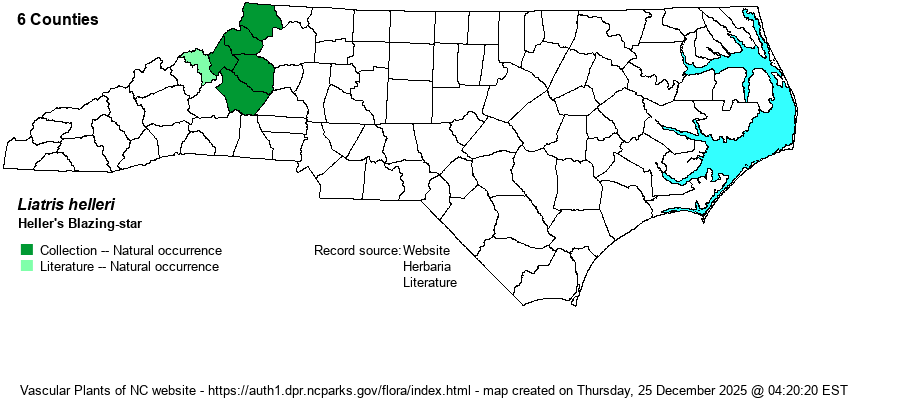| Author | Porter | |
| Distribution | Endemic to the state and limited to just a few high montane rocky summits; it is a Federally Threatened species. Weakley (2020) and many others had lumped L. turgida into this species in recent years, but he moved it back out again in 2020. Additional research is warranted.
Endemic to northwestern NC. | |
| Abundance | Rare to locally uncommon, primarily at Grandfather Mountain. This is a Federally Threatened species. | |
| Habitat | Limited to high elevation rock outcrops, crevices, and ledges. |
| Phenology | Flowering and fruiting July - mid September. | |
| Identification | Blazing-stars typically have single unbranched stems, many slender leaves, and a terminal spike-like inflorescence of disk florets only. They grow from very hard, roundish, underground corms. Heller's Blazing-star grows only 8-12 inches tall, the lower leaves narrowly elliptic to rather spatula-shaped, with the middle and upper leaves rapidly narrower and shorter. The heads are "middling- sized", have 7-17 pink-purple florets, and involucral bracts have blunt tips. From L. microcephala it can be told by more florets per head (7-17 vs. 4-6) and from L. pilosa it can be told by stems and leaves weakly punctate-glandular (vs. usually strongly so). The latter species usually is not found growing on rocks/outcrops. See also L. turgida. | |
| Taxonomic Comments | Weakley (2020) retains turgida as a good species, but cites journal papers which underline the controversy.
| |
| Other Common Name(s) | None | |
| State Rank | S2 | |
| Global Rank | G2Q | |
| State Status | T | |
| US Status | LT | |
| USACE-agcp | | |
| USACE-emp | | |

